Mish's Global Economic Trend Analysis |
| Nonfarm Payroll +120,000, Unemployment Rate Fell .1 to 8.2%, Record 87,897,000 "Not in Labor Force" Posted: 06 Apr 2012 09:51 AM PDT Quick Notes About the Unemployment Rate
Over the past several years people have dropped out of the labor force at an astounding, almost unbelievable rate, holding the unemployment rate artificially low. Some of this was due to major revisions last month on account of the 2010 census finally factored in. However, most of it is simply economic weakness. Jobs Report at a Glance Here is an overview of today's release.
Recall that the unemployment rate varies in accordance with the Household Survey not the reported headline jobs number, and not in accordance with the weekly claims data. March 2012 Jobs Report Please consider the Bureau of Labor Statistics (BLS) March 2012 Employment Report. Nonfarm payroll employment rose by 120,000 in March, and the unemployment rate was little changed at 8.2 percent, the U.S. Bureau of Labor Statistics reported today. Employment rose in manufacturing, food services and drinking places, and health care, but was down in retail trade. Unemployment Rate - Seasonally Adjusted  Nonfarm Employment - Payroll Survey - Annual Look - Seasonally Adjusted 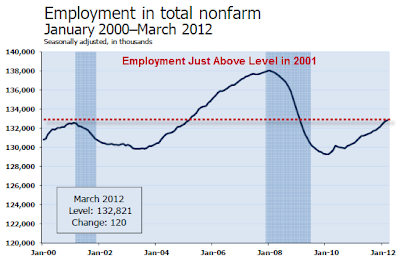 Actual employment is about where it was just prior to the 2001 recession. Nonfarm Employment - Payroll Survey - Monthly Look - Seasonally Adjusted  click on chart for sharper image Between January 2008 and February 2010, the U.S. economy lost 8.8 million jobs. Since a recent employment low in February 2010, nonfarm payrolls have expanded by 3.6 million jobs. Of the 8.8 million jobs lost between January 2008 and February 2010, 41 percent have been recovered. Statistically, 125,000+- jobs a month is enough to keep the unemployment rate flat. For a discussion, please see Question on Jobs: How Many Does It Take to Keep Up With Demographics? The average employment gain over the last 25 months has been 143,000, barely enough (statistically speaking) to make a dent in the unemployment rate. Yet, the civilian unemployment rate has fell from 9.8% to 8.3%. Current Report Jobs 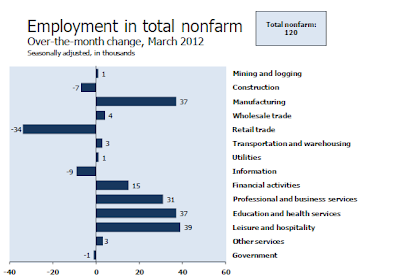 Average Weekly Hours 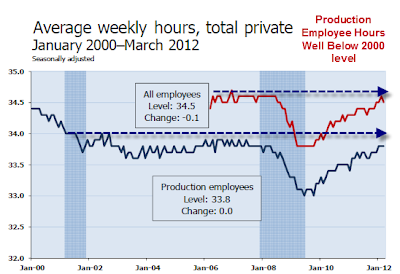 Index of Aggregate Weekly Hours 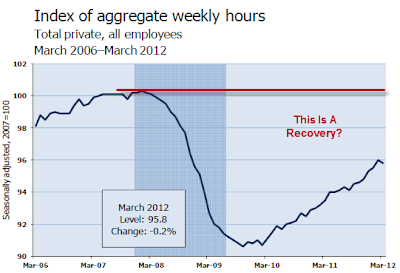 Average Hourly Earnings vs. CPI 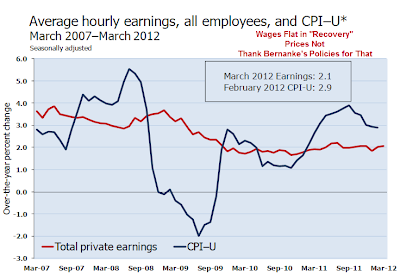 "Success" of QE2 and Operation Twist
BLS Birth-Death Model Black Box The BLS Birth/Death Model is an estimation by the BLS as to how many jobs the economy created that were not picked up in the payroll survey. The Birth-Death numbers are not seasonally adjusted while the reported headline number is. In the black box the BLS combines the two coming out with a total. The Birth Death number influences the overall totals, but the math is not as simple as it appears. Moreover, the effect is nowhere near as big as it might logically appear at first glance. Do not add or subtract the Birth-Death numbers from the reported headline totals. It does not work that way. Birth/Death assumptions are supposedly made according to estimates of where the BLS thinks we are in the economic cycle. Theory is one thing. Practice is clearly another as noted by numerous recent revisions. Birth Death Model Adjustments For 2011  Birth Death Model Adjustments For 2012 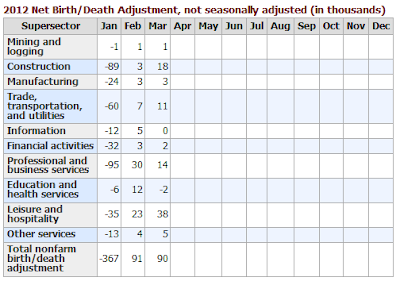 Birth-Death Note Once again: Do NOT subtract the Birth-Death number from the reported headline number. That approach is statistically invalid. Household Survey Data 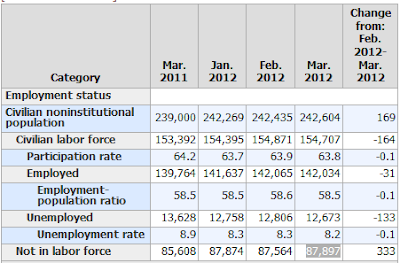 click on chart for sharper image In the last year, the civilian population rose by 3,604,000. Yet the labor force only rose by 1,315,000. Those not in the labor force rose by 2,289,000. That is an amazing "achievement" to say the least, and as noted above most of this is due to economic weakness not census changes. Decline in Labor Force Factors
Were it not for people dropping out of the labor force, the unemployment rate would be well over 11%. Part Time Status  click on chart for sharper image There are 7,672,000 workers who are working part-time but want full-time work. Table A-15  click on chart for sharper image Table A-15 is where one can find a better approximation of what the unemployment rate really is. Notice I said "better" approximation not to be confused with "good" approximation. The official unemployment rate is 8.2%. However, if you start counting all the people that want a job but gave up, all the people with part-time jobs that want a full-time job, all the people who dropped off the unemployment rolls because their unemployment benefits ran out, etc., you get a closer picture of what the unemployment rate is. That number is in the last row labeled U-6. U-6 is much higher at 14.5%. Both numbers would be way higher still, were it not for millions dropping out of the labor force over the past few years. Grossly Distorted Statistics Given the complete distortions of reality with respect to not counting people who allegedly dropped out of the work force, it is easy to misrepresent the headline numbers. Digging under the surface, the drop in the unemployment rate over the past two years is nothing but a statistical mirage. Things are much worse than the reported numbers indicate. Note the drop in U-6 unemployment this month as the Civilian Labor Force fell by 164,000. This is beyond statistical noise, to the point of pure statistical bullsheet. Mike "Mish" Shedlock http://globaleconomicanalysis.blogspot.com Click Here To Scroll Thru My Recent Post List |
| Another Plunge in 3-Month Rolling Average of Petroleum and Gasoline Usage for Jan, Feb, March 2012 Posted: 06 Apr 2012 12:16 AM PDT Here is an update from reader Tim Wallace on gasoline and petroleum usage for the first three months of 2012. The chart shows Jan-Feb-March 2012 usage vs. the same three months in prior years.  click on chart for sharper image Wallace writes ... Hello MishAlso consider Ceridian Fuel Index Up 0.3 Percent in March, Down 2.2 Percent From Year Ago Note that Ceridian real-time diesel fuel usage is back to mid-2005 levels. GDP vs. PCI  Mike "Mish" Shedlock http://globaleconomicanalysis.blogspot.com Click Here To Scroll Thru My Recent Post List |
| You are subscribed to email updates from Mish's Global Economic Trend Analysis To stop receiving these emails, you may unsubscribe now. | Email delivery powered by Google |
| Google Inc., 20 West Kinzie, Chicago IL USA 60610 | |

No comments:
Post a Comment